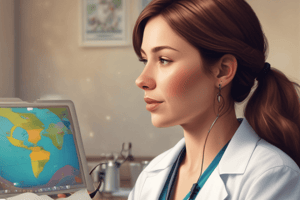Podcast
Questions and Answers
What is the primary goal of patient education?
What is the primary goal of patient education?
- To provide emotional support to patients
- To reduce healthcare costs by promoting self-care
- To ensure patient compliance with treatment plans
- To help individuals, families, or communities achieve optimal levels of health (correct)
What is the role of the nurse in teaching and learning?
What is the role of the nurse in teaching and learning?
- To provide emotional support to patients
- To assess patient knowledge and understanding
- To impart knowledge through a series of directed activities
- Nurses are legally responsible for providing education to all patients (correct)
What is the definition of teaching in the context of patient education?
What is the definition of teaching in the context of patient education?
- A one-way process of imparting knowledge
- Imparting knowledge through a series of directed activities (correct)
- A process of understanding and applying newly acquired concepts
- A collaborative process between nurse and patient
What is the purpose of feedback in teaching and learning?
What is the purpose of feedback in teaching and learning?
What is the primary focus of patient education?
What is the primary focus of patient education?
What is the definition of learning in the context of patient education?
What is the definition of learning in the context of patient education?
What is the significance of effective communication in teaching and learning?
What is the significance of effective communication in teaching and learning?
What is a key aspect of teaching as communication?
What is a key aspect of teaching as communication?
What is the ultimate goal of patient education?
What is the ultimate goal of patient education?
Which domain of learning is focused on the development of mental skills and knowledge?
Which domain of learning is focused on the development of mental skills and knowledge?
What is a crucial factor in motivation to learn?
What is a crucial factor in motivation to learn?
In which setting do nurses have more time to identify patients' learning needs and provide comprehensive ongoing education?
In which setting do nurses have more time to identify patients' learning needs and provide comprehensive ongoing education?
What is essential to consider when predicting the topic and level of instruction required for patient education?
What is essential to consider when predicting the topic and level of instruction required for patient education?
Which of the following is NOT a basic learning principle?
Which of the following is NOT a basic learning principle?
What is a key aspect of the learning environment?
What is a key aspect of the learning environment?
In an acute care setting, what should nurses do early in instruction?
In an acute care setting, what should nurses do early in instruction?
What is critical in clinical judgment for patient education?
What is critical in clinical judgment for patient education?
Why is it essential to confirm with patients and family caregivers in an acute care setting?
Why is it essential to confirm with patients and family caregivers in an acute care setting?
What is the primary focus of the assessment phase in the nursing process?
What is the primary focus of the assessment phase in the nursing process?
Which of the following is NOT a consideration during the planning phase of the nursing process?
Which of the following is NOT a consideration during the planning phase of the nursing process?
What is the primary goal of the implementation phase of the nursing process?
What is the primary goal of the implementation phase of the nursing process?
Which instructional method is most effective for patients with low literacy skills?
Which instructional method is most effective for patients with low literacy skills?
Why is it important to consider cultural diversity during the implementation phase?
Why is it important to consider cultural diversity during the implementation phase?
What is the purpose of the 'teach-back' method in patient education?
What is the purpose of the 'teach-back' method in patient education?
Which of the following is a characteristic of the 'entrusting' teaching approach?
Which of the following is a characteristic of the 'entrusting' teaching approach?
What is the primary goal of the evaluation phase in the nursing process?
What is the primary goal of the evaluation phase in the nursing process?
Which of the following is a consideration during the analysis and nursing diagnosis phase?
Which of the following is a consideration during the analysis and nursing diagnosis phase?
What is the purpose of maintaining learning attention and participation during the implementation phase?
What is the purpose of maintaining learning attention and participation during the implementation phase?
Flashcards are hidden until you start studying
Study Notes
Purposes of Patient Education
- The primary goal of patient education is to help individuals, families, or communities achieve optimal levels of health.
- Patient education aims to:
- Maintain and promote health and illness prevention
- Restore health
- Help individuals cope with impaired functions
Teaching and Learning
- Teaching involves imparting knowledge through a series of directed activities.
- Learning is the process of understanding and applying newly acquired concepts.
- Nurses are legally responsible for providing education to all patients.
Domains of Learning
- Cognitive learning involves the acquisition of knowledge.
- Affective learning involves the development of attitudes or emotions.
- Psychomotor learning involves the acquisition of skills.
Basic Learning Principles
- Motivation to learn is crucial, and can be enhanced by using theory, cultural factors, and active participation.
- Readiness to learn is also essential.
- Ability to learn depends on developmental capability, learning in children and adults, health literacy, and physical capability.
- The learning environment also plays a significant role in the learning process.
Clinical Judgment in Patient Education
- Nurses should use their knowledge of a patient's health condition to predict the topic and level of instruction required.
- In clinic, home care, and rehabilitation settings, nurses have more time to identify patients' learning needs and provide comprehensive ongoing education.
Nursing Process
Assessment
- Assessment involves understanding the patient's perspective.
- Learning needs, motivation to learn, readiness and ability to learn, environmental factors, resources for learning, and health literacy should be assessed.
Analysis and Nursing Diagnosis
- Analysis and nursing diagnosis involve identifying learning outcomes and setting priorities.
Planning and Outcomes Identification
- Planning involves setting outcomes, prioritizing, and organizing teaching material.
- Teamwork and collaboration are essential in this stage.
Implementation
- Implementation involves maintaining learning attention and participation.
- Teaching approaches include telling, participating, entrusting, and reinforcing.
- Instructional methods include verbal one-on-one discussion, group instruction, preparatory instruction, demonstrations, analogies, and simulation.
- Cultural diversity and special needs of children and older adults should be considered.
- Teaching tools and resources should be used effectively.
Evaluation
- Evaluation involves assessing patient outcomes using methods such as teach-back.
Studying That Suits You
Use AI to generate personalized quizzes and flashcards to suit your learning preferences.




